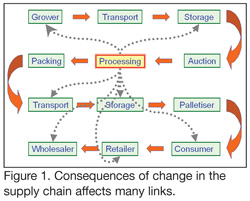Food industry scientists, engineers and food safety program managers often wonder why it is so hard to get funding for the application of new and better food safety technologies when the benefits are so obvious and clear. There are numerous examples of both improved existing technologies and novel technologies that offer food manufacturers greater food hazard prevention and control capabilities and increased production efficiencies to boot. Although the benefits of implementing new technologies may be obvious and clear to the food company’s scientists and program managers—and even to other food safety professionals higher up the corporate decision-making ladder—the benefits often are not as immediately apparent to corporate managers who make the ultimate budget decisions.
Indeed, these two basic perceptions—that of the mid-level or senior food safety manager’s view that introducing new hazard prevention, control and verification technologies is an investment of high benefit to the company versus the corporate decision-maker’s view of food safety technology investment as a cost center—are world’s apart. Why is there such a vast discrepancy between these two perceptions, and what can the food safety scientist, technician, engineer or program manager do to reduce the chasm?
By understanding the reasons behind the decisions of those who hold the purse strings, food safety professionals will be better equipped to make a plausible business case for the introduction of improved or innovative technologies that support the mission of the company’s food protection programs and systems.
Understanding the Hurdles
There are quite a number of reasons for the differing perceptions. First, many of us are so enthusiastic about the potential benefits of new food safety technologies that we run the risk of basing our ideas and arguments on incomplete or debatable data. Or, we fail to develop a plausible business case. There also may be hurdles that have nothing to do with differences in perception, but are of a more practical nature. For example, it may be that a new technology has great potential—but applied somewhere else and/or by others. Perhaps the reality is that the site in which this technology will be used is in an area where expansion of the facility is limited and cannot accommodate new equipment. There may be problems with patents and licensing requirements. And, of course, there may be regulatory issues. No regulator is going to accept a new process if it does not fit into the current regulatory scheme.
Let’s take a look at each of these hurdles with an eye toward how scientists, engineers and other food safety program managers in sanitation, process control and quality assurance departments can prove the benefits of new technologies to the decision makers.
Incomplete or Debatable Data
If you try to convince your company to invest in a new food safety technology, and you are serious, you had better be absolutely certain about your “blanks.” Management is going to ask for this information and this can be painful if you aren’t prepared with the answers. It is sensible to use only peer-reviewed references pertaining to the technology you are proposing. The peer review process is a central pillar of research by which independent scientists review findings and identify weaknesses before they are published. Peer-reviewed research involves rigorous scientific scrutiny of new methods and technologies and, as such, are useful because they provide empirical substantiation of the technology’s application parameters.
It is important to gather enough data to ensure that your proposal is not incomplete. In other words, avoid situations in which you have to explain later, after you’ve presented the documentation, that perhaps there are some flaws in your story or that you (or worse, a colleague) discovered some unexpected effects that change important findings of your data. Be sure that your case is not based on just one or two lucky shots.
Thus, make sure that you present good science. For example, do not argue that the food preservation technology or process does not alter the product processed. It does, inevitably. It kills the bugs, so why would it leave everything else alone? Heat changes proteins and therefore enzymes, and over time, destroys membranes. Microorganisms do not survive this and neither does the product, which becomes digestible and that is useful. In particular, destruction of the cellular membranes (in the case of vegetable products) is very welcome as it makes nutrients available. Other processes do other things that microorganisms dislike, causing them to die. A good example of this is pulsed electric field (PEF) technology, which does not destroy enzymes but does perforate microbial and eukaryotic cell membranes. The cells (and hence the microbes) die and the nutrients become available. With a correct process design, it seems that there are few or no adverse effects on the finished product. This year, PEF reached industrial application and is being used to make fresh fruit juices microbiologically safe.
Finally, make certain that the technology is readily available or can be developed at acceptable costs in an acceptable timeframe. Do not try to sell the proposal if this is NOT possible. It may be necessary to identify research needs pertaining to potential undesired side effects and on eliminating or remedying these in order to supply complete data to decision makers.
Weak Business Case
A strong and convincing business case is essential and must be made in cooperation with all relevant stakeholders. A weak business case is one that does not address the concerns of primary stakeholders and relevant decision makers within your company’s hierarchy. Their concerns likely focus on costs related to the equipment, implementation and maintenance of the new technology or system; the capability of the system to increase production efficiencies or to reduce costs in some other way, such as energy or labor savings; and so forth. As a scientist, engineer or food safety program manager, your concerns will focus heavily on the effectiveness of the new technology, its capabilities with regard to the reduction of potential food safety hazards and the ability of personnel to properly operate or troubleshoot the equipment. Both parties will, of course, share the primary concern of producing safe foods.
How can you build a solid business case? First, you need to make certain that you know all of the decision makers, in particular those within the company who you know will be asked to provide input or advice on your proposal, including senior management, regulatory affairs and maintenance, sanitation or other operational departments on which the new technology will have an impact. It is important to include the marketing and sales department professionals who will eventually sell the finished product—you need to be able to articulate how the new technology will provide them with, or perhaps limit them from, making certain marketing or labeling claims.
After you have identified the potential in-house influencers and decision makers, discuss all relevant information with those in the company who support the idea, paying special attention to any negative aspects and to the limitations of the new food safety technology. These may prove more important than the positive ones. In these discussions, never try to hide anything and never oversell—it will result in disappointment and that works against the goal. Naysayers, or “antis,” may have more influence than you, so discuss the concerns they raise and listen carefully. You need to have the answers ready—and the answers must be convincing—to effectively address and eliminate those concerns. Again, a good business case shows the potential of the proposal, complete with all “ifs” and “whens”—and includes pessimistic estimates. If you don’t include the existing or potential downsides of the technology, others will—and may possibly use incorrect information.
External Stakeholders
In addition to the decision makers in the company, it is important that you identify and consult with external stakeholders—proponents, opponents, neutrals, champions and colleagues—in regulatory bodies, universities, industry trade organizations, and within obvious limits, the competition. Carefully listen to their convictions, doubts and feelings, and then take into account what you learn. If you consider them stakeholders, they probably have influence in some way that pertains to the adoption of new technology. For example, it is a good idea to consult local or federal regulators to make certain that you know whether there are regulatory issues with the new technology—and whether the company will be able to cope with these issues during implementation.
External stakeholders may also include opinion influencers such as consumer organizations, environmentalists, and the mass media or trade press. For example, consumers are strongly influenced by “antis,” as the food industry has witnessed with gamma irradiation and genetically modified food technologies. Although these have much scientific evidence to support their safe use, they have yet to enjoy widespread support of the public due to bad press driven by these groups. Preempt this by working together with consumer organizations at an early stage to promote the use and benefits of the new technology, and make yourself available for interviews and as an editorial resource for the press on the scientific underpinnings and benefits of applying novel or improved treatments.
Wrong Location
A technology may have great potential, but this potential cannot be realized unless it is sited correctly. In other words, the site where you initially believe the technology should be applied to be beneficial to the company may unexpectedly turn out to be somewhere else. The technology may even have to be applied by another company. This will be the case when the product originates from that “somewhere else.” If the raw materials come from the Southern Hemisphere and are sold in the Northern Hemisphere, it may well be that the technology—particularly if it is a preservation technology—has to be applied in the southern location. If so, many difficulties can arise, such as additional regulatory compliance problems because the company must now cope with regulations in two different countries that may be far apart both in terms of geography and policy.
Food Processing Patents Obstacles
Patenting is an expensive process that requires extra research and may require expensive attorneys and lawyers. Despite their clever formulations, most processing patents can be easily circumvented. Worse, patented processes usually take off after the patent has expired. Food preservation by high pressure and pulsed electric fields are good examples. Application of HPP technology to preserve food started around 1990 in Japan—almost 100 years after the conception of the idea in 1895. PEF treatment was invented in 1960 but the first application took place just this year, 45 years later. Meanwhile, many patent applications had been filed and patents expired. PurePulse Technologies in San Diego, CA, did not survive the hurdles. It could be argued that food processing patents do nothing more than slow down technological progress by diverting resources to lawyers, causing extra experimental work to justify claims, and causing much duplication, or more likely multiplication, of work that could have been avoided if researchers were allowed to cooperate.
Patents can become hurdles to the introduction of new technologies—and particularly to making your business case for adoption—in other ways, as well. Examples include wanting patent protection before deciding on an application, or using patents from others that might be infringed. Licensing negotiations also may take quite an effort.
Regulatory and Legislative Disharmony
And, of course, there may be regulatory issues. No regulator is going to accept a new process if it does not fit into the current regulations somewhere. If that is the case, it becomes a significant regulatory hurdle since the development and implementation of new regulations or the modification of existing regulations may take many years, during which you will need to provide evidence on the safety of the process and the product. In many cases, this will cause the proposal to be immediately shelved.
Food regulations and legislation exist to protect the consumer, not to deprive the consumer from better food products. However, significant hurdles to the adoption of new or improved technologies are caused by the differences between regulations between countries. These differences often lead to duplication of testing and the arduous task of following different protocols. Harmonization of global regulations is an important issue that needs sufficient attention and resources—but that is another story about which you may read online at www.globalharmonization.org, or in Food Safety Magazine’s October/ November 2005 issue, “Industry Waits for Green Light on Harmonized Food Safety Standards).
Unwilling Deciders
Making decisions means taking risks and (almost) no one knowingly takes unknown risks—and certainly not for proposals that they do not understand in the first place. Of course, you might try to lure people into taking unknown risks unknowingly, but you may be able to do so only once.
 It is important to realize that there is no need to convince the colleagues who agree with you: They are already your fans. Convincing deciders is not the same as teaching motivated students. You need to get the attention of those who decide, even though they may not be interested in technology. They have other interests and based on experience, decision makers often are suspicious because every time someone comes with an “obviously good” proposal for a new process, a whole range of unmentioned consequences pop up. Changes in processing impacts almost every link in the supply chain (Figure 1). In addition, there are issues like quality and safety, tracking and tracing, buildings, personnel, energy and taxes to consider. It all adds to the cost of the proposal, which in turn adds to the unwillingness of the decider.
It is important to realize that there is no need to convince the colleagues who agree with you: They are already your fans. Convincing deciders is not the same as teaching motivated students. You need to get the attention of those who decide, even though they may not be interested in technology. They have other interests and based on experience, decision makers often are suspicious because every time someone comes with an “obviously good” proposal for a new process, a whole range of unmentioned consequences pop up. Changes in processing impacts almost every link in the supply chain (Figure 1). In addition, there are issues like quality and safety, tracking and tracing, buildings, personnel, energy and taxes to consider. It all adds to the cost of the proposal, which in turn adds to the unwillingness of the decider.
In many cases, the decider does not want to hear about a new process, and certainly not from a scientist. Yes, as a scientist you have an image problem, nicely illustrated by Gary Larson in the Far Side cartoon some years ago. The cartoon shows a scientist “melted” (ala Oz’s Wicked Witch of the West) on a lab bench surrounded by his white-coated colleagues. One of the scientists says, “My God! It is Professor Dickle!...Weinberg, see if you can make out what the devil he was working on, and the rest of you get back to your stations.” In turn, the decider probably presents an image problem to you, as they have other things in mind. They have been educated differently, as editorial cartoonist Jeff Danziger understood perfectly when he drew his “At the Graduate School of Business” cartoon. The professor at the lecture podium tells the class, “Now, I know that you all want to make money…but today we are going to discuss making…things. Actual things.” And a business student pictured at the back of the room comments, “Things?! I don’t want to make things. I want to make money!” The student sitting next to him replies, “Listen, let’s sue the business school. We could make some money that way.”
Overcoming the obstacle of the unwilling decider means paying special attention to including all of the elements of making the business case for the adoption of new food safety technology, as well as communicating the science behind the benefits of adoption.
Leverage Your Knowledge for Success
Given all these hurdles, it may seem that it is better not to try to sell science and technology to deciders. It often seems like the more decision power one possesses, the less one’s understanding of technology and the harder you must work to convince them. The lives of decision makers would likely be easier if science were less complicated, but many are not sure whether they can really do without. Therefore, you may get the opportunity to educate and innovate, which you should be careful not to miss.
Just make certain that they get all relevant information and be sure that you know what is relevant—to the deciders. This includes a well-presented summary of the business case and a list of the internal and external stakeholders who support the proposal. Present credible data to show that you know what you are talking about, and discuss the benefits and drawbacks of implementing the technology. Focus on advantages of the new technology, not on the drawbacks of traditional technologies. (Deciders already know the traditional technologies do work!) Make certain they understand what you present.
Finally, there are two very basic rules that are useful to anyone making a proposal for change: 1. Listen to understand, and 2. Speak to be understood. Johan Cruyff, a famous Dutch football player (well, of my time) once said, “If I had wanted you to understand it, I would have explained it better.” Ultimately, if you want to successfully cross the finish line with a winning proposal, you’ll find that making a plausible business case for change rests on your ability to “explain it better.”
Huub L.M. Lelieveld has more than 40 years’ experience in industrial microbiology, bioprocessing and food technology. As a senior technologist at Unilever The Netherlands, Lelieveld was responsible for new initiatives in international multidisciplinary projects in microbiology and food science and technology. Now retired, he is a consultant to Unilever and currently spearheads the Global Harmonization Initiative (GHI), a working group of international food scientists dedicated to harmonizing international food safety legislation and regulation between countries to advance science-based food safety policy and promote the use of advanced technology to enhance food safety worldwide.




